2007 NISSAN TIIDA roof
[x] Cancel search: roofPage 4569 of 5883
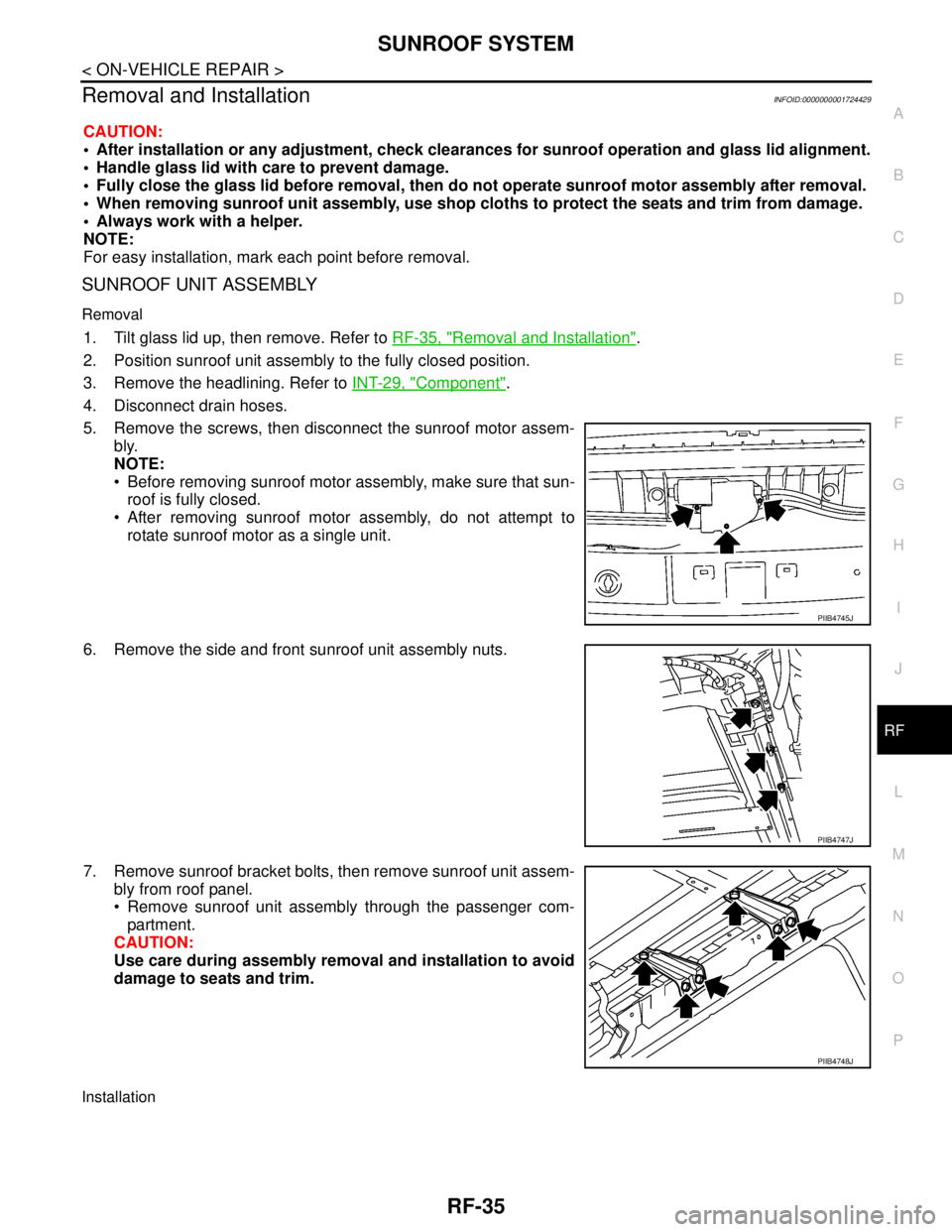
SUNROOF SYSTEM
RF-35
< ON-VEHICLE REPAIR >
C
D
E
F
G
H
I
J
L
MA
B
RF
N
O
P
Removal and InstallationINFOID:0000000001724429
CAUTION:
After installation or any adjustment, check clearances for sunroof operation and glass lid alignment.
Handle glass lid with care to prevent damage.
Fully close the glass lid before removal, then do not operate sunroof motor assembly after removal.
When removing sunroof unit assembly, use shop cloths to protect the seats and trim from damage.
Always work with a helper.
NOTE:
For easy installation, mark each point before removal.
SUNROOF UNIT ASSEMBLY
Removal
1. Tilt glass lid up, then remove. Refer to RF-35, "Removal and Installation".
2. Position sunroof unit assembly to the fully closed position.
3. Remove the headlining. Refer to INT-29, "
Component".
4. Disconnect drain hoses.
5. Remove the screws, then disconnect the sunroof motor assem-
bly.
NOTE:
Before removing sunroof motor assembly, make sure that sun-
roof is fully closed.
After removing sunroof motor assembly, do not attempt to
rotate sunroof motor as a single unit.
6. Remove the side and front sunroof unit assembly nuts.
7. Remove sunroof bracket bolts, then remove sunroof unit assem-
bly from roof panel.
Remove sunroof unit assembly through the passenger com-
partment.
CAUTION:
Use care during assembly removal and installation to avoid
damage to seats and trim.
Installation
PIIB4745J
PIIB4747J
PIIB4748J
Page 4570 of 5883
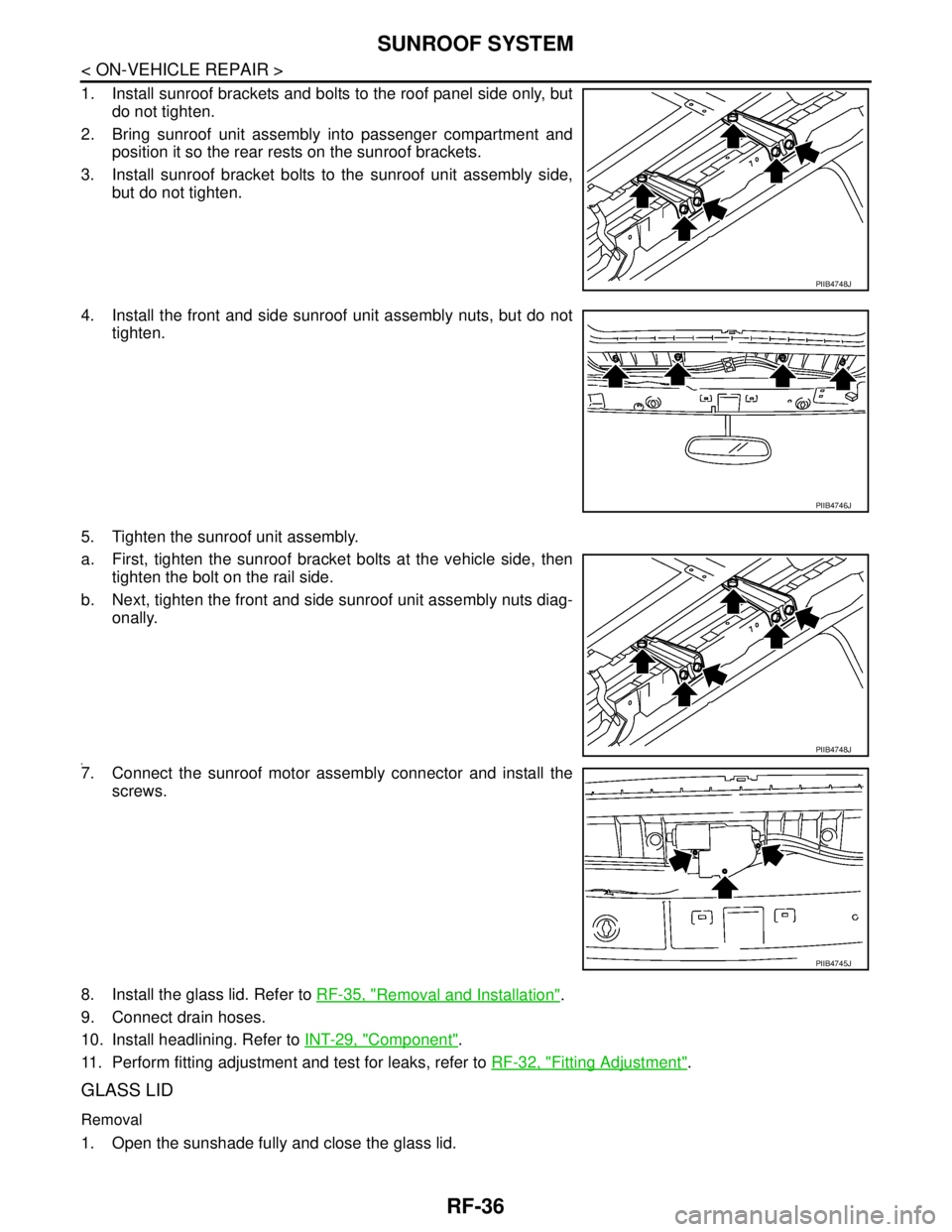
RF-36
< ON-VEHICLE REPAIR >
SUNROOF SYSTEM
1. Install sunroof brackets and bolts to the roof panel side only, but
do not tighten.
2. Bring sunroof unit assembly into passenger compartment and
position it so the rear rests on the sunroof brackets.
3. Install sunroof bracket bolts to the sunroof unit assembly side,
but do not tighten.
4. Install the front and side sunroof unit assembly nuts, but do not
tighten.
5. Tighten the sunroof unit assembly.
a. First, tighten the sunroof bracket bolts at the vehicle side, then
tighten the bolt on the rail side.
b. Next, tighten the front and side sunroof unit assembly nuts diag-
onally.
6.7. Connect the sunroof motor assembly connector and install the
screws.
8. Install the glass lid. Refer to RF-35, "
Removal and Installation".
9. Connect drain hoses.
10. Install headlining. Refer to INT-29, "
Component".
11. Perform fitting adjustment and test for leaks, refer to RF-32, "
Fitting Adjustment".
GLASS LID
Removal
1. Open the sunshade fully and close the glass lid.
PIIB4748J
PIIB4746J
PIIB4748J
PIIB4745J
Page 4571 of 5883
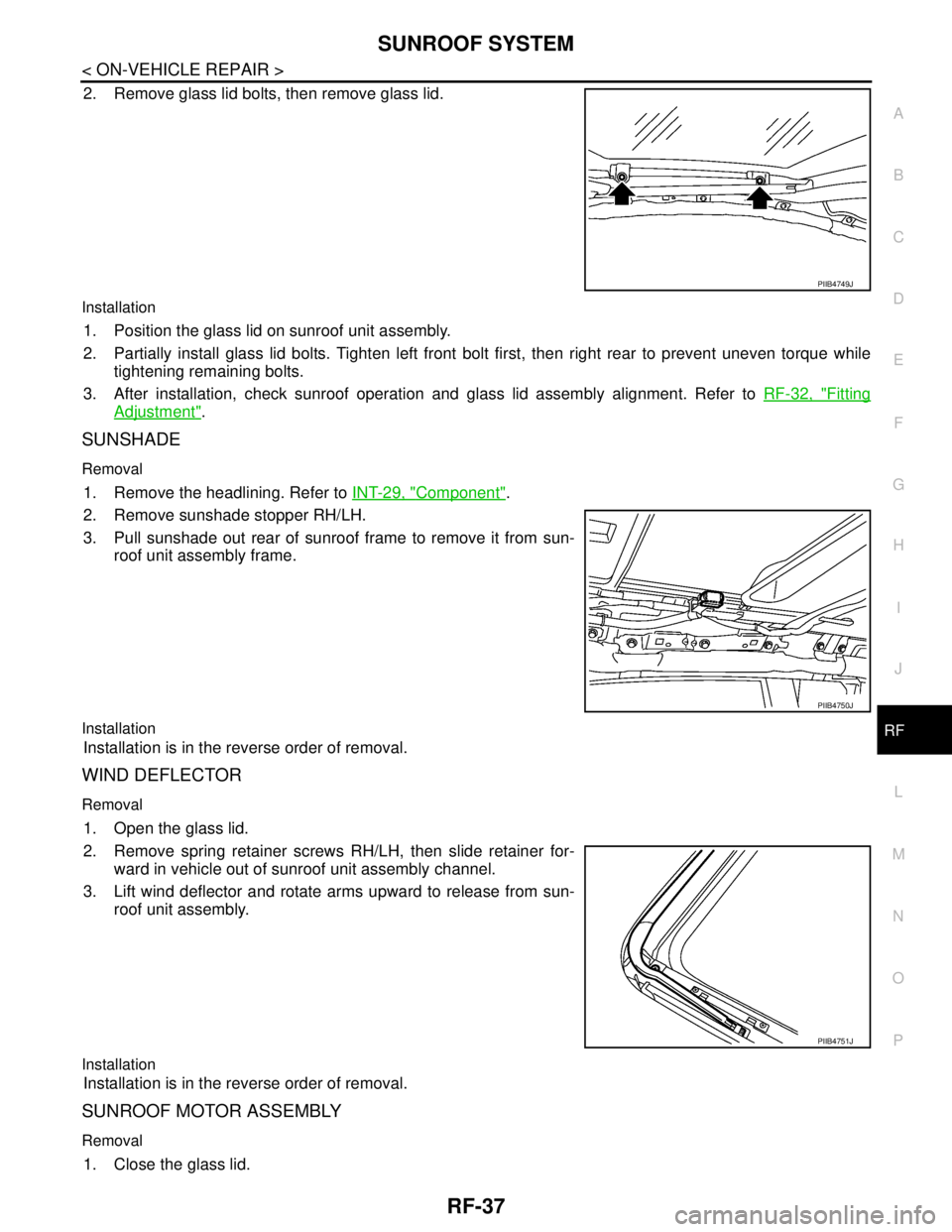
SUNROOF SYSTEM
RF-37
< ON-VEHICLE REPAIR >
C
D
E
F
G
H
I
J
L
MA
B
RF
N
O
P
2. Remove glass lid bolts, then remove glass lid.
Installation
1. Position the glass lid on sunroof unit assembly.
2. Partially install glass lid bolts. Tighten left front bolt first, then right rear to prevent uneven torque while
tightening remaining bolts.
3. After installation, check sunroof operation and glass lid assembly alignment. Refer to RF-32, "
Fitting
Adjustment".
SUNSHADE
Removal
1. Remove the headlining. Refer to INT-29, "Component".
2. Remove sunshade stopper RH/LH.
3. Pull sunshade out rear of sunroof frame to remove it from sun-
roof unit assembly frame.
Installation
Installation is in the reverse order of removal.
WIND DEFLECTOR
Removal
1. Open the glass lid.
2. Remove spring retainer screws RH/LH, then slide retainer for-
ward in vehicle out of sunroof unit assembly channel.
3. Lift wind deflector and rotate arms upward to release from sun-
roof unit assembly.
Installation
Installation is in the reverse order of removal.
SUNROOF MOTOR ASSEMBLY
Removal
1. Close the glass lid.
PIIB4749J
PIIB4750J
PIIB4751J
Page 4572 of 5883
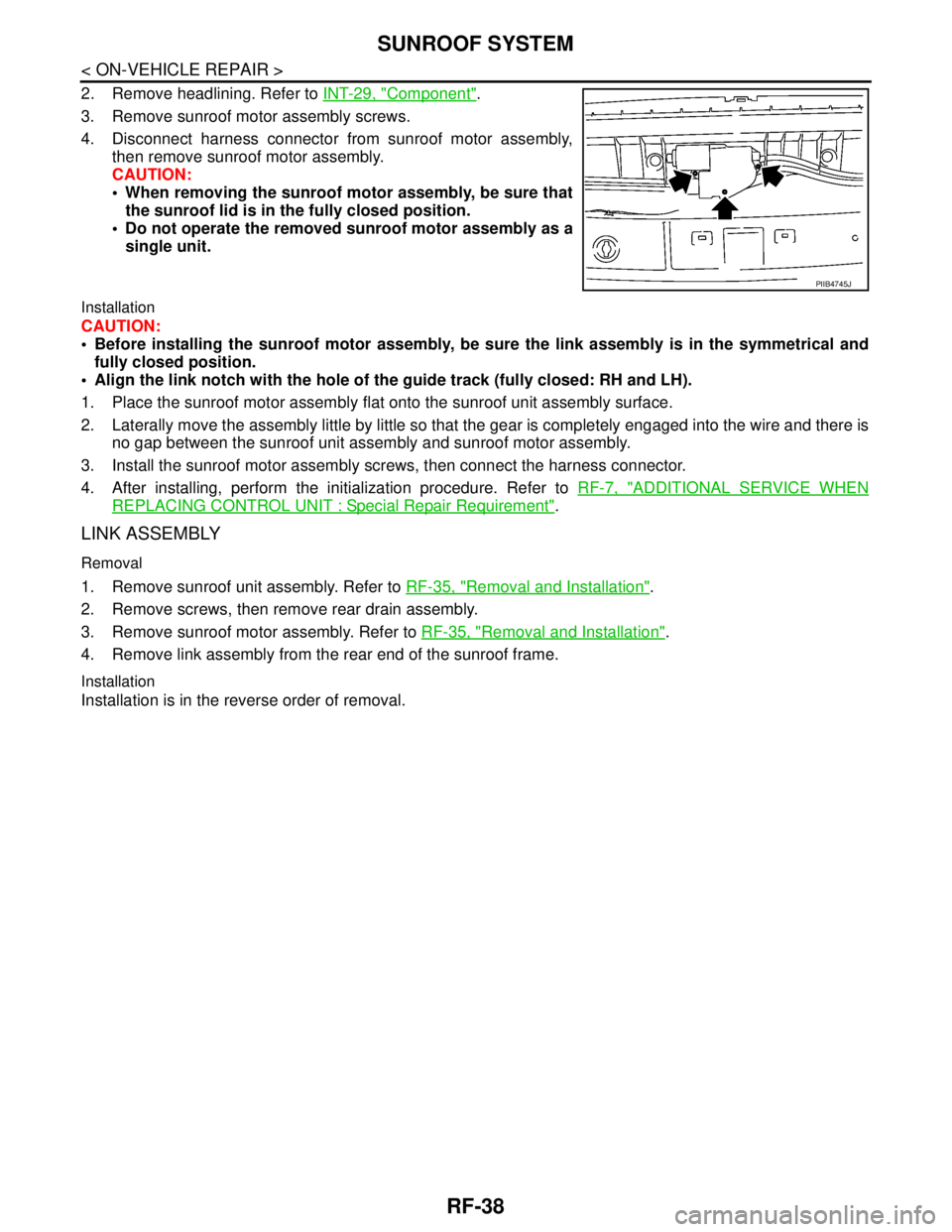
RF-38
< ON-VEHICLE REPAIR >
SUNROOF SYSTEM
2. Remove headlining. Refer to INT-29, "Component".
3. Remove sunroof motor assembly screws.
4. Disconnect harness connector from sunroof motor assembly,
then remove sunroof motor assembly.
CAUTION:
When removing the sunroof motor assembly, be sure that
the sunroof lid is in the fully closed position.
Do not operate the removed sunroof motor assembly as a
single unit.
Installation
CAUTION:
Before installing the sunroof motor assembly, be sure the link assembly is in the symmetrical and
fully closed position.
Align the link notch with the hole of the guide track (fully closed: RH and LH).
1. Place the sunroof motor assembly flat onto the sunroof unit assembly surface.
2. Laterally move the assembly little by little so that the gear is completely engaged into the wire and there is
no gap between the sunroof unit assembly and sunroof motor assembly.
3. Install the sunroof motor assembly screws, then connect the harness connector.
4. After installing, perform the initialization procedure. Refer to RF-7, "
ADDITIONAL SERVICE WHEN
REPLACING CONTROL UNIT : Special Repair Requirement".
LINK ASSEMBLY
Removal
1. Remove sunroof unit assembly. Refer to RF-35, "Removal and Installation".
2. Remove screws, then remove rear drain assembly.
3. Remove sunroof motor assembly. Refer to RF-35, "
Removal and Installation".
4. Remove link assembly from the rear end of the sunroof frame.
Installation
Installation is in the reverse order of removal.
PIIB4745J
Page 4604 of 5883
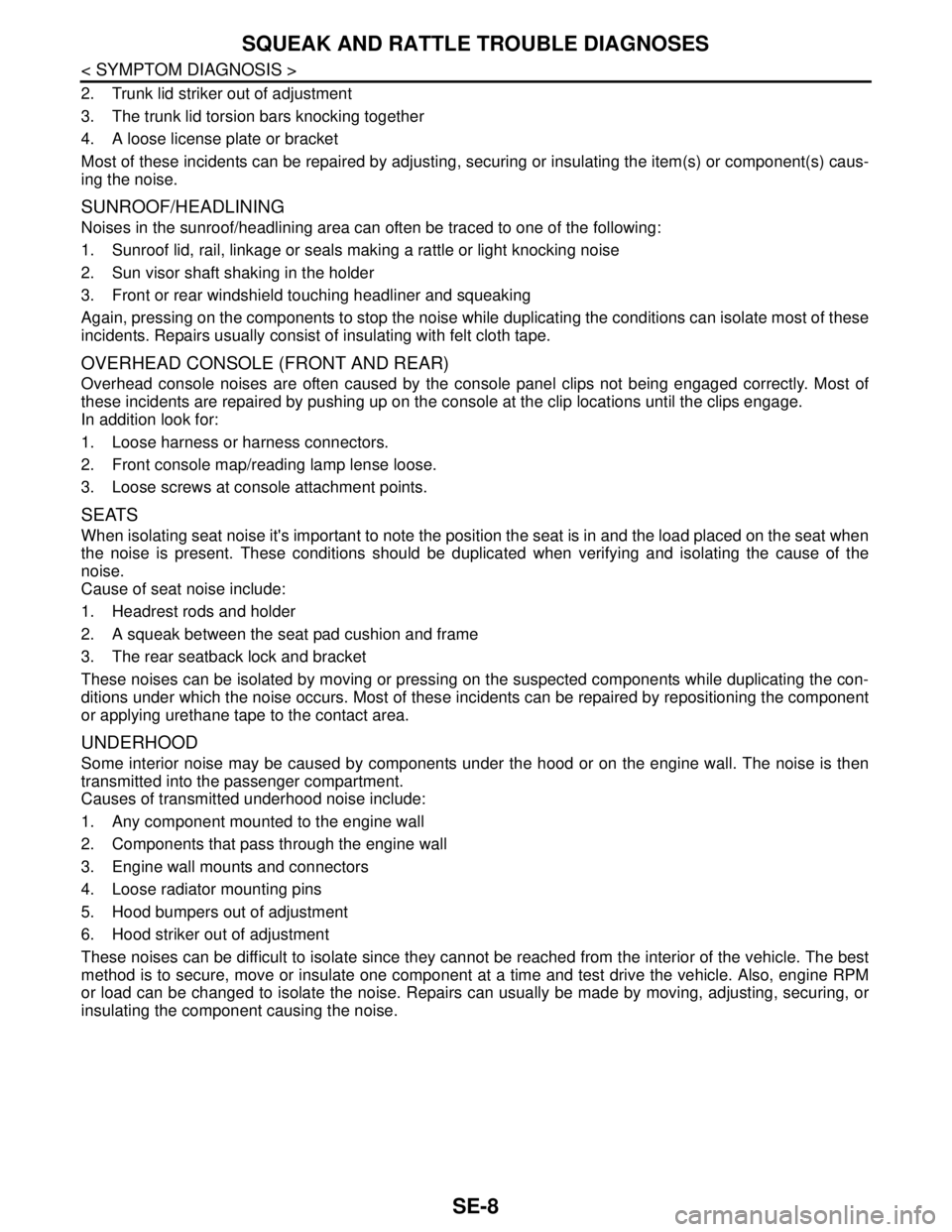
SE-8
< SYMPTOM DIAGNOSIS >
SQUEAK AND RATTLE TROUBLE DIAGNOSES
2. Trunk lid striker out of adjustment
3. The trunk lid torsion bars knocking together
4. A loose license plate or bracket
Most of these incidents can be repaired by adjusting, securing or insulating the item(s) or component(s) caus-
ing the noise.
SUNROOF/HEADLINING
Noises in the sunroof/headlining area can often be traced to one of the following:
1. Sunroof lid, rail, linkage or seals making a rattle or light knocking noise
2. Sun visor shaft shaking in the holder
3. Front or rear windshield touching headliner and squeaking
Again, pressing on the components to stop the noise while duplicating the conditions can isolate most of these
incidents. Repairs usually consist of insulating with felt cloth tape.
OVERHEAD CONSOLE (FRONT AND REAR)
Overhead console noises are often caused by the console panel clips not being engaged correctly. Most of
these incidents are repaired by pushing up on the console at the clip locations until the clips engage.
In addition look for:
1. Loose harness or harness connectors.
2. Front console map/reading lamp lense loose.
3. Loose screws at console attachment points.
SEATS
When isolating seat noise it's important to note the position the seat is in and the load placed on the seat when
the noise is present. These conditions should be duplicated when verifying and isolating the cause of the
noise.
Cause of seat noise include:
1. Headrest rods and holder
2. A squeak between the seat pad cushion and frame
3. The rear seatback lock and bracket
These noises can be isolated by moving or pressing on the suspected components while duplicating the con-
ditions under which the noise occurs. Most of these incidents can be repaired by repositioning the component
or applying urethane tape to the contact area.
UNDERHOOD
Some interior noise may be caused by components under the hood or on the engine wall. The noise is then
transmitted into the passenger compartment.
Causes of transmitted underhood noise include:
1. Any component mounted to the engine wall
2. Components that pass through the engine wall
3. Engine wall mounts and connectors
4. Loose radiator mounting pins
5. Hood bumpers out of adjustment
6. Hood striker out of adjustment
These noises can be difficult to isolate since they cannot be reached from the interior of the vehicle. The best
method is to secure, move or insulate one component at a time and test drive the vehicle. Also, engine RPM
or load can be changed to isolate the noise. Repairs can usually be made by moving, adjusting, securing, or
insulating the component causing the noise.
Page 4626 of 5883
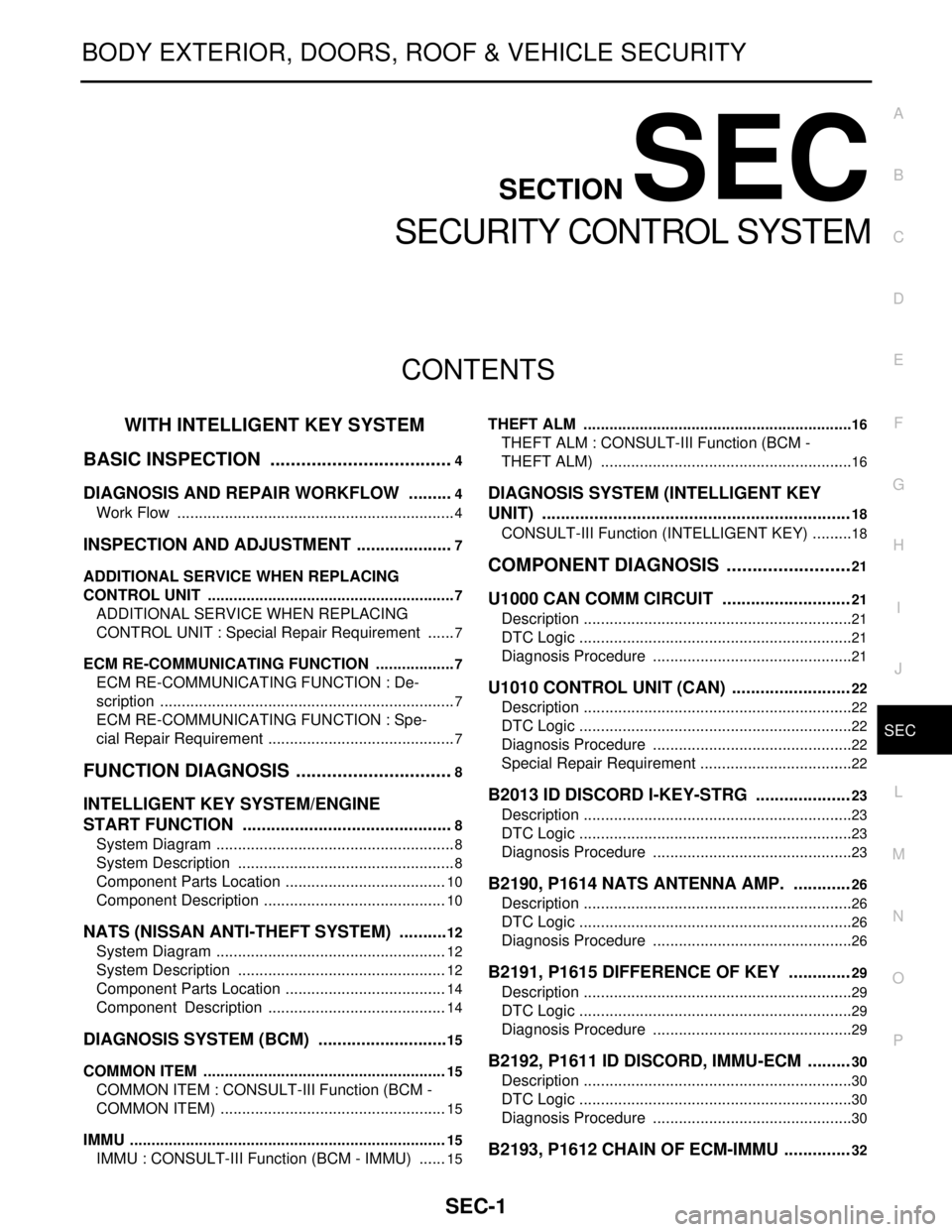
SEC-1
BODY EXTERIOR, DOORS, ROOF & VEHICLE SECURITY
C
D
E
F
G
H
I
J
L
M
SECTION SEC
A
B
SEC
N
O
P
CONTENTS
SECURITY CONTROL SYSTEM
WITH INTELLIGENT KEY SYSTEM
BASIC INSPECTION ....................................
4
DIAGNOSIS AND REPAIR WORKFLOW ..........4
Work Flow .................................................................4
INSPECTION AND ADJUSTMENT .....................7
ADDITIONAL SERVICE WHEN REPLACING
CONTROL UNIT ..........................................................
7
ADDITIONAL SERVICE WHEN REPLACING
CONTROL UNIT : Special Repair Requirement .......
7
ECM RE-COMMUNICATING FUNCTION ...................7
ECM RE-COMMUNICATING FUNCTION : De-
scription .....................................................................
7
ECM RE-COMMUNICATING FUNCTION : Spe-
cial Repair Requirement ............................................
7
FUNCTION DIAGNOSIS ...............................8
INTELLIGENT KEY SYSTEM/ENGINE
START FUNCTION .............................................
8
System Diagram ........................................................8
System Description ...................................................8
Component Parts Location ......................................10
Component Description ...........................................10
NATS (NISSAN ANTI-THEFT SYSTEM) ...........12
System Diagram ......................................................12
System Description .................................................12
Component Parts Location ......................................14
Component Description ..........................................14
DIAGNOSIS SYSTEM (BCM) ............................15
COMMON ITEM .........................................................15
COMMON ITEM : CONSULT-III Function (BCM -
COMMON ITEM) .....................................................
15
IMMU ..........................................................................15
IMMU : CONSULT-III Function (BCM - IMMU) .......15
THEFT ALM ...............................................................16
THEFT ALM : CONSULT-III Function (BCM -
THEFT ALM) ...........................................................
16
DIAGNOSIS SYSTEM (INTELLIGENT KEY
UNIT) .................................................................
18
CONSULT-III Function (INTELLIGENT KEY) ..........18
COMPONENT DIAGNOSIS .........................21
U1000 CAN COMM CIRCUIT ...........................21
Description ...............................................................21
DTC Logic ................................................................21
Diagnosis Procedure ...............................................21
U1010 CONTROL UNIT (CAN) .........................22
Description ...............................................................22
DTC Logic ................................................................22
Diagnosis Procedure ...............................................22
Special Repair Requirement ....................................22
B2013 ID DISCORD I-KEY-STRG ....................23
Description ...............................................................23
DTC Logic ................................................................23
Diagnosis Procedure ...............................................23
B2190, P1614 NATS ANTENNA AMP. ............26
Description ...............................................................26
DTC Logic ................................................................26
Diagnosis Procedure ...............................................26
B2191, P1615 DIFFERENCE OF KEY .............29
Description ...............................................................29
DTC Logic ................................................................29
Diagnosis Procedure ...............................................29
B2192, P1611 ID DISCORD, IMMU-ECM .........30
Description ...............................................................30
DTC Logic ................................................................30
Diagnosis Procedure ...............................................30
B2193, P1612 CHAIN OF ECM-IMMU ..............32